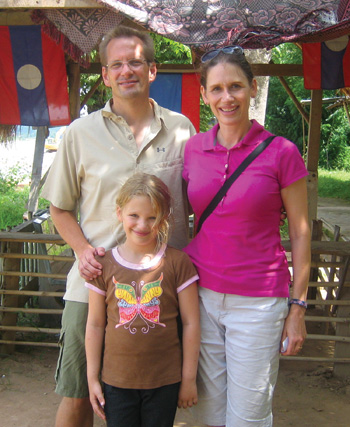For two decades, Deborah Luik flirted with disaster all over the world. This mercurial traveler, software architect and dog trainer was kidnapped in Cyprus, scammed in Portugal and harassed by drunks while pregnant in Japan. To Deborah, it was all part of the adventure.
Before she knew better, she rode an elephant in the traffic of Jaipur and hitched rides with a British officer through Wales and a Muslim porn smuggler on a camel through India. Naturally, when she got married, it would be with a fellow adventurer.

Paul, Kaia and Deborah Luik travel to Don Sao, Laos, a small island in the Golden Triangle, where you can see three countries at once: Laos, Thailand and Myanmar.
Most people might think about staying stateside at that point. Not the Luiks; Paul went to ice-climbing school in Colorado, and Deborah headed for India – just in time for the historic Ayodhya riots.
Eighteen trips and 27 countries later they finally decided there was just one adventure that could trump the rest: having a child.
Kaia arrived Nov. 25, 2002. Travel priorities changed. Safety and security topped the list. Deborah, who left the fast-paced world of startup companies to focus on family, became the ultimate trip planner.
“Suddenly the question was: ‘Will this experience enrich her life more than endanger it?’” said the always irreverent Deborah. The priority became, not “How far can we get off the beaten path” but “Where’s the fun factor?”
“What we realized was that having fun was… well… fun,” Deborah said. “Once we let go of ‘I’m a traveler, not a tourist; I eschew tourist destinations; I want to see the real… fill in the blank….’ we began to actually see the real place.”
They planned trips around Kaia’s interests: finding playmates, feeding animals, playing on the beach.
When she was 3, they started little trips overseas: Puerto Rico, the Yucatan, Hawaii.
When Kaia turned 7, it was time to take the Fun Factor further afield. In Thailand, they arranged a stay in a hill-tribe village. That’s where Kaia discovered her fascination with village life, which became a theme of subsequent trips. They also discovered another way to connect with local children: by teaching them. Driving around Northern Thailand, they saw a sign inviting English speakers to teach a class – and so they did. They repeated the performance in Malaysia. In India, they discovered an orphanage with girls Kaia’s age, and she taught them how to make friendship bracelets. The girls taught Kaia and Deborah a Hindi circle dance.
It was in Thailand that Kaia developed an interest in “helping people do their work:” collecting shellfish, planting rice, building cooking fires, feeding pigs.
“When you explain to people what you want, they indulge your kid, and you get to see all kinds of things from the inside – agriculture, cooking things, fishing.” Kaia learned how ride on a water buffalo and weave on a hand loom in India, shoot darts from a blowgun and make batiks in Malaysia, and drive nearly anything: a motorboat, a rickshaw taxi, a horse-drawn tonga, even a camel cart.
“An adult can do this too,” said Deborah, “but you feel more self-conscious.”
The next year it was Malaysia, where Kaia’s first run-in with a riot in Kuala Lumpur was met with an equally kid-oriented solution: three days in an indoor amusement park at Berjaya Times Square.
This year, the family traveled to the Spiti Valley in the remote Himalayan province of Himachal Pradesh. Paul’s plan was to climb the 18,000-foot Mount Chokula, while the girls would ride yaks to Komic (14,400 feet) to see local development initiatives. Unfortunately, global climate change foiled their plans; the entire yak population had contracted hoof-and-mouth disease due to unseasonably warm weather. Instead, they learned from a veterinarian and a tribal healer about contrasting treatments of the calamitous disease.
How the Luiks will top their travels now is anyone’s guess. Although, if it’s up to Kaia, they might just stay home; she’s expressed an interest in staying home, playing “village” and learning to knit.
Leave a Reply